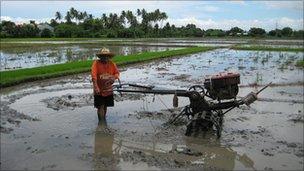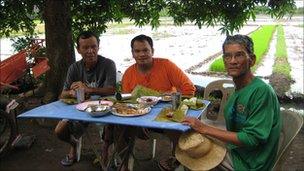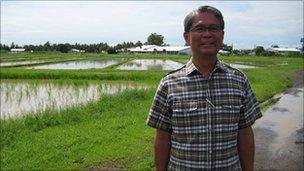The Philippines tries to reduce its dependency on rice
- Published
Kate McGeown visits a rice gene bank
The Philippines is a tropical country, with a climate ideally suited to growing rice.
Many of its neighbours, notably Thailand and Vietnam, produce surplus to their domestic requirements - earning much-needed revenue from exporting their rice around the world.
But for decades now, the Philippines has not even been able to produce enough to feed its own people, let alone sell its rice to others. In fact, in 2010, it was the world's largest rice importer, buying in 2.45 million tonnes.
It's not as if the country lacks agricultural expertise. Ironically, it's home to some of the most eminent rice scientists in the world, based at the International Rice Research Institute (IRRI) in Los Banos, a few hours' drive south of Manila.
According to Dr William Padolina, IRRI's Deputy Director General for Operations, the Philippines faces several big challenges.
Losses from harvesting, milling, drying, and rice that is bought but not consumed - "all of these together would account for about 30% reduction in what you can recover from your harvest," he says.
"Then you have to look at climate change - you have to cope with adverse weather and disasters that will severely reduce your rice production," Dr Padolina adds.

New measures include irrigating new areas to be farmed
There's also the problem, for small-scale farmers especially, that the best seeds, as well as resources to adequately irrigate and fertilise their land, are sometimes prohibitively expensive.
But perhaps the biggest challenge is that although the Philippines has a lot of land, much of it is mountainous or made up of small islands, and is therefore unsuitable for rice production. And meanwhile the population is growing at about 2% a year - more than anywhere else in South East Asia.
"To feed about 95 million Filipinos, the available harvested area for rice is only 4 million hectares," said Dr Padolina.
When you compare the Philippines with neighbouring countries, it becomes clear why these figures are such a problem.
Thailand, for example, has almost 10 million hectares of harvested land, and 30 million fewer mouths to feed than the Philippines.
In fact the Philippines is already more productive per unit area than Thailand - but it needs to increase its productivity still further to avoid having to ask the Thais and others for rice imports.
Price vulnerability
The government is acutely aware of the negatives of importing huge quantities of rice. Not only is it a massive drain on the public purse, it also puts the country in an extremely vulnerable position if global rice prices increase.
When the cost of staple food items rose sharply in 2008, huge queues formed outside rice warehouses, as people desperately tried to get as much as they could.
There wasn't actually a shortage, but people started stockpiling rice just in case prices rose further, panicking others into doing the same.
Clearly something needed to be done to reduce the Philippines' reliance on foreign imports, and the current government - which came to power just over a year ago - has put a lot of emphasis on trying to change the situation.
Sitting in his office in the north of Manila, Agriculture Secretary Proceso Alcala smiles broadly when asked about the measures he's putting into place.
"We are trying very hard to introduce additional areas for irrigation… because if an area is irrigated [properly] we can have five crops in two years," he says.

The rice farmers are avid rice eaters as well
"And the improvement of seeds is also very important," he adds, saying he's trying to increase the use of certified hybrid varieties.
He's also begun a programme to teach farmers about new technology - especially water management - and streamline the process of transporting, drying and storing rice, by cutting out the middle man and buying direct from farmers.
A year into these initiatives, his plans already seem to be producing results - although he's definitely been helped by a good harvest and only minimal damage from typhoons (some years, typhoons can ruin rice harvests across large areas of the country).
Shifting from rice
The Philippines is on target to import just 860,000 tonnes of rice in 2011, about a third of what it imported last year - and in the process lose the unwelcome title of world's largest rice importer.
President Benigno Aquino has even stated his intention for the Philippines to become completely self-sufficient in rice by 2013 - a target which Mr Alcala is optimistic he can achieve.
In fact he's so confident that he's already looking at ways to export Philippine rice - specifically organic, or as he calls it 'fancy' rice, which is increasingly being grown in upland areas.

Dr William Padolina says land area for growing rice is limited in the Philippines
Mr Alcala also has some ideas of how to persuade Filipinos to eat less rice, thus reducing the pressure on farmers to grow such huge volumes for domestic consumption.
"We are trying to encourage our people to shift from rice to white corn," he says. "We're also pushing for root crops to become staples too."
For farmers like Rogelio Carillo, who spends most of his days hard at work in his paddy fields just down the road from the International Rice Research Institute, such matters are not of prime concern. He worries more about having enough money to buy good seed for the next harvest, and fuel for his tractor.
But any attempt to wean him off eating rice is likely to be met with fierce resistance.
Rice is his favourite food - he eats it three times a day, he says with a smile. "We need to eat rice. This is where we get the strength to farm our fields."
No matter how difficult it is to produce enough, or how much has to be imported, it seems unlikely that Filipinos will lose their passion for rice any time soon.
- Published4 March 2011
- Published4 March 2011